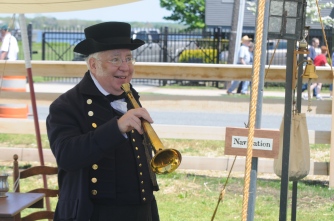
On this fine autumn Saturday members of the Historical Society of Cecil County gathered for the organizations 82rd annual meeting. The crowd socialized, heard annual reports, elected officers, talked about the past, enjoyed dessert, and participated in some excellent historical programming, during the afternoon.
President Paula Newton opened the assembly with remarks about activities this past year. After the reports and election of new officers President Newton honored Lucia G. Demond with the presentation of the Ernest A. Howard Award. The Society presents this prestigious recognition to individuals who have made extraordinary contributions to the preservation of Cecil’s heritage, working in significant ways to promote, protect and preserve the built environment, folkways or relics of earlier times
Lucia, the sixth recipient, teamed up with her husband, Nick (a former president), contributing countless volunteers hours to benefit the county and the society. Constantly working to shed light on the area’s past they broadened the work of the Society, which included increasing hours of operation and contributing numerous historic manuscripts with great research value. In addition the couple was active in heritage preservation with other local organizations such as the Upper Bay Museum. “We thank Lucia for her tireless lifelong effort to protect and preserve our historic resources and for serving as an ambassador, promoting the County’s heritage,” President Paula Newton remarked.
About the time the last photos had been snapped two youngsters from the 1860s burst into the meeting, excitedly shouting that the Civil War Chaplain, the Rev. Joseph T. Brown, was coming. Rev. Brown served as a chaplain to the Maryland 6th Volunteer Regiment, and he was returning home to Cherry Hill, fresh from Libby Prison and the all too vivid memories of major battles.
It was now time for the audience to get involved as the excited youngsters urged them to hurry up and greet the returning veteran. So as members spilled outside on this beautiful Saturday afternoon, they heard a voice off in the distance signing an old Methodist Hymn. As the man walked toward the assembly, everyone soon saw that it was the Civil War Chaplin returning from Libby Prison.
Following greetings and handshakes from old friends who had been separated for some time, the tired veteran of major battles lead the crowd into the Cherry Hill United Methodist Church, where he took the pulpit to share first hand stories. The account, mixed with great emotion, was from a man who had survived the great conflict and he told about selecting prisoners to be executed, hearing about the assassination of President Lincoln, and the experiences of terrible battles. Periodically the Methodist preacher led the assembled audience in the signing of old hymns and those beautiful sounds filled the sanctuary.
Once Rev. Brown finished telling his Civil War story and interacting with the crowd, the Libby Prison Minstrels, a group of Civil War musicians, shared songs of the Civil War, using instruments of yesterday and today. It had been a fine afternoon of inspirational true stories, participatory history, and special music as the members peeked into the daily life of a chaplain during the war.



Notes: The Civil War Chaplain was played by Rev. Hubert Jicha of North East United Methodist Church. The two youngsters from the 1860s were Riley and William Graham; and the script for the living history program was written by Eric Mease.
















